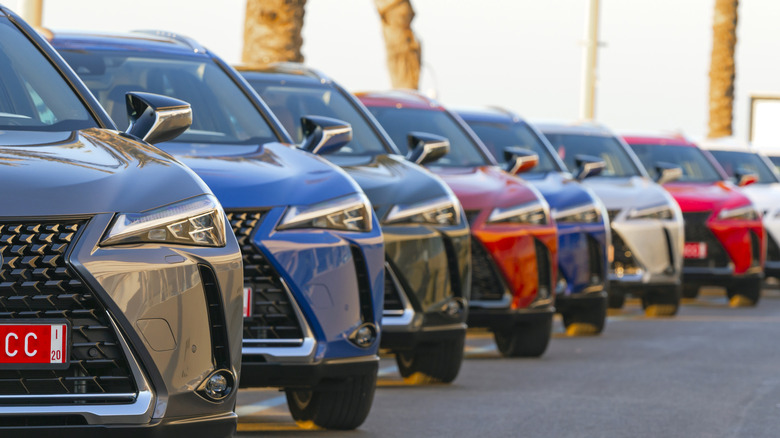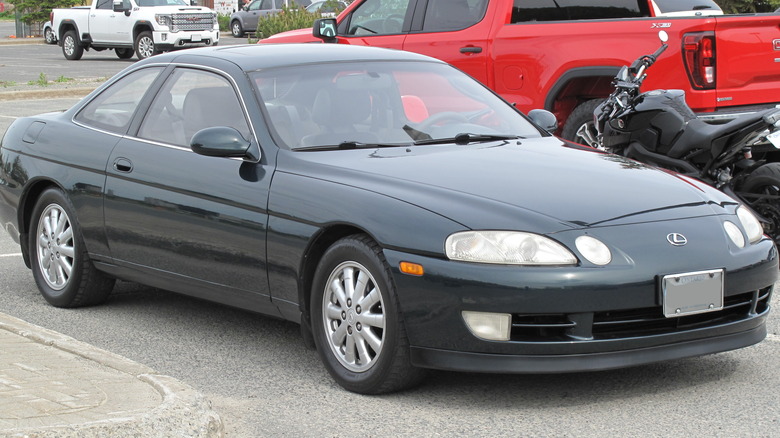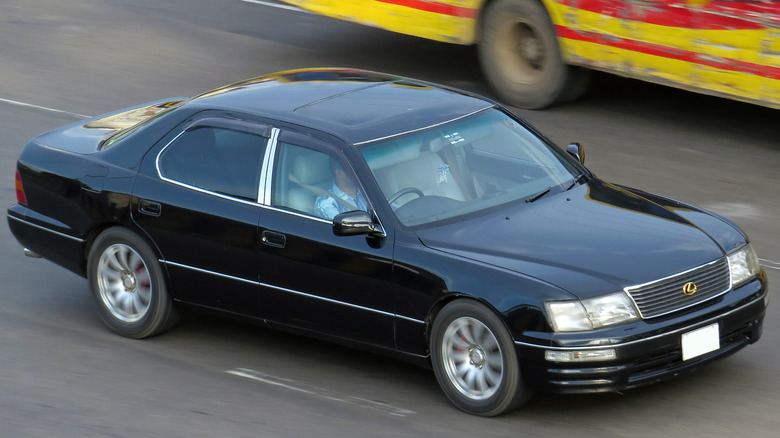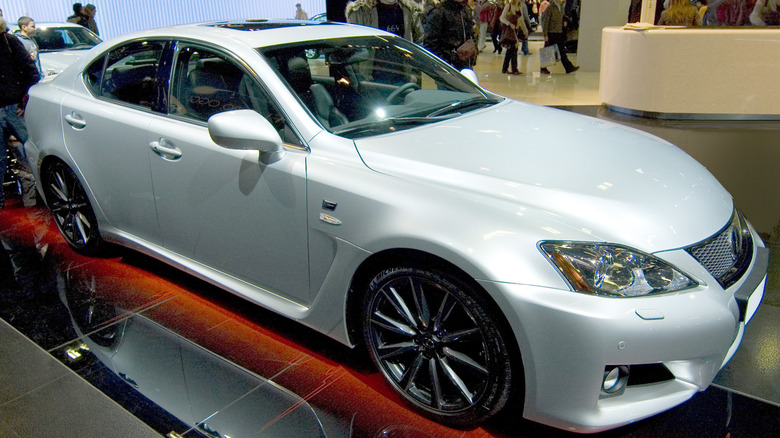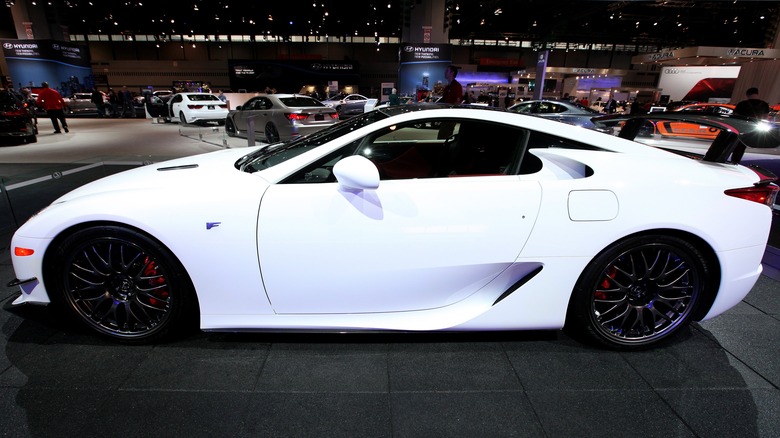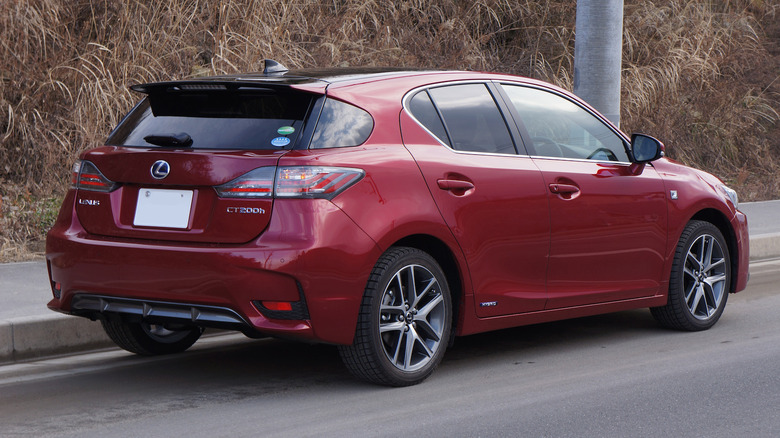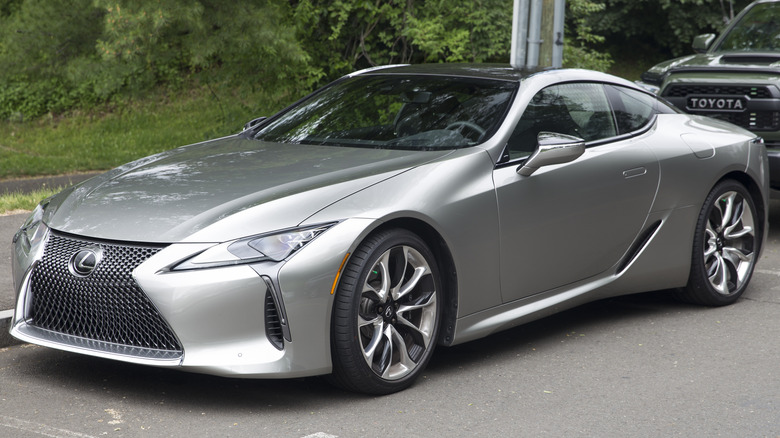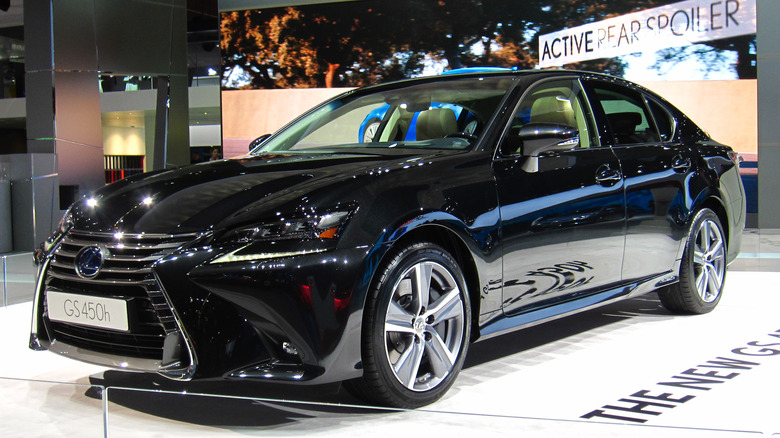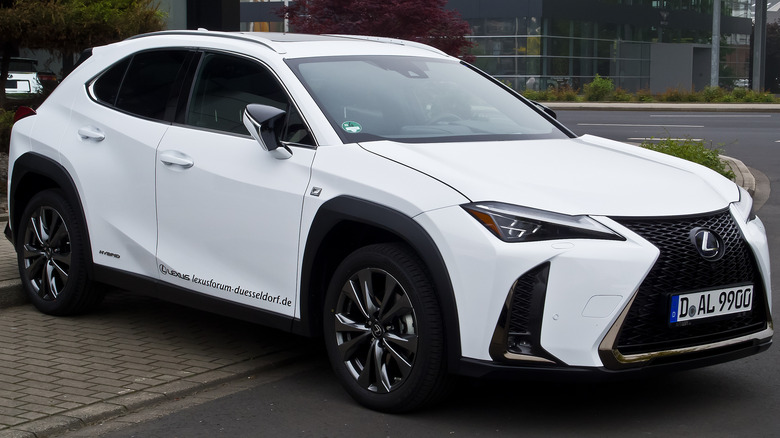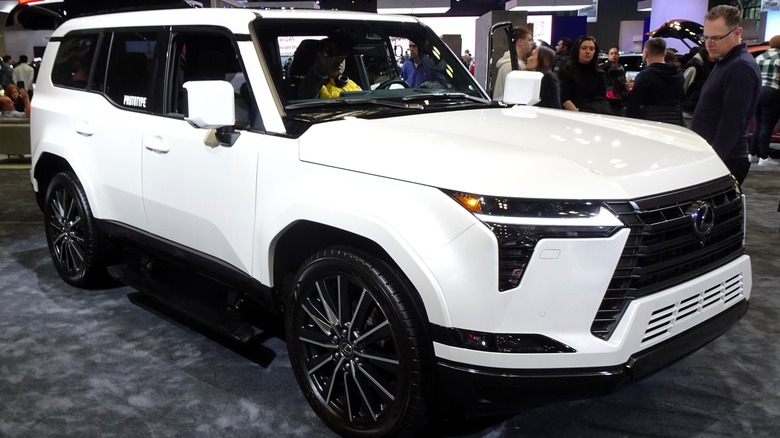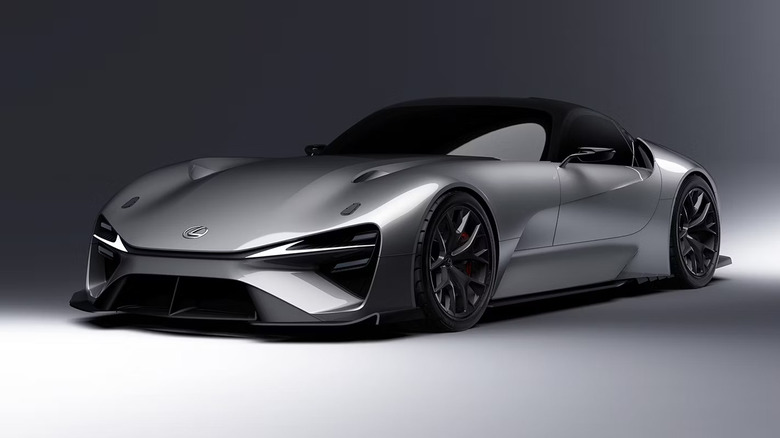10 Of The Best Looking Lexus Models Ever Designed
It is not often that a new car company appears on the scene, but that's just what happened back in 1989 -– kind of. After decades of success, Toyota, which had built some of the most beloved and iconic cars of the 20th century, sought to branch out.
The Japanese automaker already had a reputation for reliability, but reliability isn't always sexy. While the Celica and 4Runner had their fans, not many people associated the Camry or Corolla with performance. However, what Toyota had going for it was a world-class production ethos and virtually unparalleled engineering prowess. Yukiyasu Togo, who accepted the Chief Executive role at Toyota in 1983, believed that the automaker had a gap in its lineup. The baby boomer generation had proven loyal to the reliable automaker, but now they were all grown up, along with their bank accounts and their taste in automobiles.
Togo believed that Toyota could take everything it knew about automaking and develop the next generation of true premium luxury vehicles. With the board's blessing, Togo sparked the development of the Circle F project in 1983. No one knew it then, but the F stood for flagship and represented the birth of an entirely new line under the Toyota umbrella. The Circle F project had a six-year gestation, and it arrived in 1989 as the Lexus LS 400.
Some of the most beautiful cars of recent years have sprung from Togo's vision. Building everything from supercars to SUVs, Lexus produced vehicles known not just for luxury and power but for being some of the most beautiful cars on the road. Join us as we dive into some of the best-looking Lexus models ever to emerge from a sketchpad.
1992 Lexus SC
If you're nostalgic for the '90s, you know that while some of the looks from that decade may be slightly dated, but that doesn't mean they're not still cool. The first-generation Lexus SC strikes that rare combination of being definitively old-school while remaining aesthetically pleasing.
The first Lexus coupe designed in the United States, the SC established itself as a competent, sporty option. Between 1991 and 2010, Lexus only produced two generations of the SC — along with a significant refresh to the second-gen version in 2005 – each with its own merits. With a brand that's only been around since 1989, the closest you'll get to a vintage feel is the first-gen SC. The first generation lasted until 2000 with a look somewhat reminiscent of the Honda Prelude, which we mean as an enormous compliment. Low, lean, and just plain cool, the SC looks like it oozes through the streets.
The 4.0-liter V8 makes 250 horses. It is not stunning by today's standards, but it is plenty of fun in the right hands. The nice thing about old-school cool is that — unlike most of the other cars on this list — it's fairly accessible, with an average used price around $13,000.
2000 Lexus LS400
The LS 400 was everything to Toyota's effort to break into the luxury market. It took six years to bring the vision of designers, engineers, and executives to life. It was the answer to whether Toyota could build a luxury car with the same success it enjoyed with the Camry and Corolla. The first generation LS 400 endured for five years before being replaced by the second generation in 1995. However, Lexus was not content with letting the luxury technology or the design in its cars age. The mid-generation refresh debuted in 1997, and in the final year of this generation, the 2000 model arrived.
Through the 1990s, it was no secret that European firms were the players to beat in the luxury market, and Lexus was not shy about imitating the likes of Mercedes. That's not to say the 2000 LS 4000 replicates a Mercedes — although the long hood, paradoxically squared-off curves, and sweeping C-pillar echo the best the Germans had to offer at the time. It just looked like something an executive would ride in, which is precisely what Lexus was aiming for. Even a quarter century later, the first LS 400 of the millennium is pleasing to the eye. That's no small feat, as timelessness is an indicator of spectacular design, and the 2000 LS 400 certainly has it.
2007 Lexus IS F
To the contemporary eye, the first-generation IS — first produced as the Toyota Altezza in 1998 before its 2000 arrival as the Lexus IS in U.S. and European markets — looks like a product of the '90s, with contemporary Mitsubishi Lancer or Honda Civic vibes. There is nothing at all wrong with either of those fine cars, but that is certainly not a comparison Yukiyasu Togo would have welcomed for his luxury brand.
The LS 400 may have been aimed at BMW's 7-series and Mercedes' S-class, but what about competition lower in the range? The Lexus IS first appeared in 1998 as a standard sedan, but has been available as a convertible and even a sport wagon in later generations. However, it seemed to really hit its stride with the second generation. With a squatty profile and swept front quarter panel drawing the eye to the rear wheel, the 2007 IS-F looks like it is sweeping down a highway even when standing still. This should be no surprise since the project's initial chief designer, Nobuaki Katayama, is a former racing driver.
Lexus debuted its second-gen IS at the 2005 Geneva Motor Show. The highest performing variant of the IS, the IS-F, was a rear-wheel-drive sedan had a 5.0-liter V8 under the hood, making 417 horsepower and 372 lb-ft of torque — no small potatoes for the mid-aughts. Meant to compete with the likes of the 3-series and C-class, the IS brought a curvy sensibility lacking in either of those models.
2012 Lexus LFA
Luxury has been Lexus's main priority since its inception, but performance has never been far behind. That's why it came as little surprise when Lexus announced plans to build a supercar in 2009. What may be more shocking is that the project had been in the works as far back as 2003 — or that it would ultimately be something of a disappointment.
The Lexus LFA may have failed to sell as Lexus wished, but that was due primarily to its high cost rather than its looks. Nonetheless, the Lexus LFA supercar is unquestionably one of the best-looking Lexus designs ever. The cost of development combined with a limited production run of 500 units meant that Lexus was asking a whopping $375,000 apiece for the supercar. However, despite an F1-derived, quick-revving 4.8-liter V10 making 553 horsepower, critics derided the single-clutch transmission and significantly lower prices of competitors like Mercedes' SLS AMG.
Perhaps the LFA's initial failure added to its allure alongside its simple yet refined beauty because, despite being marked a failure, used 2012 models currently go for significantly more than they did new. The most recent sale of an LFA fetched over $500,000, and the tiny used market currently supports an average sale price of $750,000. It could be that, like a cult movie, the LFA became a fan favorite after its prime, but we prefer to think she's just a gorgeous gal.
2014 Lexus CT
Wagons were once the sole purview of the family with four kids and two dogs. However, somewhere between the high point of the station wagon in the 1970s and today, things changed. First, minivans upended the wagon life, then SUVs and crossovers changed the game again. Station wagons, besides being utilitarian, once again became cool, so Lexus decided to design a beautiful one — or at least something close.
The Lexus CT was launched in 2011 as a premium compact with a hybrid powertrain. Though it has been called a "stumpy station wagon" by reviewers such as Autoweek, it has little connection with the family vehicle of the '70s and '80s. Sleek, flowing, cool, and functional, it's definitely easier on the eyes. At the time of release, it was the smallest Lexus on the market, qualifying as a full-luxury compact.
It is not powerful, as its hybrid powerplant produces just 134 horsepower from a 1.8-liter four-cylinder and a pair of electric motors. If you want exhilarating, spring for an LFA. Still, if you want practical, beautiful, comfortable, and functional, then the CT is where it's at.
2014 Lexus LC 500
The first LC 500 dropped in 2017 with a near six-figure price tag, which means it would be a terrible misnomer to call it the poor man's LFA, although it is a breathtaking consolation price if you don't have supercar money. Like the LFA, the LC 500 sales numbers were disappointing upon its debut, selling only 3,000 units in 2017. Fortunately for Lexus fans, the company didn't drop the nameplate, and while it has only seen one generation to date, it has been one heck of a ride.
The drivetrain offers a glimpse into Lexus's thinking about the future. While the LC 500 has a 471 horsepower 5.0 liter V8, the LC500h employs Lexus' proprietary Multi-Stage Hybrid System. This hybrid powerplant combines a 3.5L V6 making 295 horsepower with an 84-cell lithium-ion battery pack providing an additional 59 horsepower. The upshot is a 20% reduction in battery volume and a 30% weight savings. Does it make up for the reduced horsepower compared to the ICE version? Probably not. However, it helped hone Lexus's EV skills for the future production of another supercar.
Whichever package consumers choose, their main worry ought to be how to settle all the whiplash lawsuits from people double-taking as it cruises past.
2015 Lexus GS
The Lexus GS was one of the earliest Lexus models. It arrived on the scene in 1993, just four years after Lexus itself. The GS, as a mid-level sedan, competed with the BMW 5-series and Mercedes E63 before being discontinued after disappointing sales resulting from outdated technology and stiff competition killed the nameplate in 2020. Its final major facelift came for the 2016 model, which is a fine-looking car. However, it is the early, original fourth generation edition from 2015 that shines with an understated simplicity.
While the GS might not have the head-snapping lines of an LFA or LS 500, its simple, muscular design is much to be appreciated. With Lexus' trademark indented grille, a pair of scowling maws beneath, and a body line that sweeps to the car's rear, the GS crouches without being menacing. That era of GS came with four engine options, including a 306 horsepower 3.5 liter V6 and a hybrid powerplant producing 338 horsepower. Not every car needs to be eye-popping, and the GS pulls off understated elegance with grace.
2019 Lexus UX
Lexus isn't only about sleek sedans and supercars. Like many other automakers over the last decade, it has entered the crowded crossover arena with the Lexus UX in 2018. Thankfully, the UX stands out. With an aggressive and angular front end, the headlights and grille give the UX a predatory appearance, but a smooth profile irons out the aggression into a shapely hatchback. Created at Toyota's ED2 design center in Nice, France, exterior designer Stephan Rasmussen received instructions to build a sculpted product that looked capable and vigorous.
Though wrapped in the safety and luxury features one expects from Lexus, the UX may not be as capable as competitors like the Subaru Crosstrek, which affords owners all-wheel drive that the front-wheel drive UX lacks. The debut UX uses a 2.0-liter inline four-cylinder to make 169 horsepower. It likely won't win many races, but urban explorers tend not to participate in track weekends.
The UX is still in its first generation, without significant cosmetic changes and the expected year-to-year internal updates. From a styling standpoint, the design looks as fresh and attractive as it was when it first came out.
2024 Lexus GX
You're not a luxury automaker without a full-sized SUV in the lineup, and the GX has been Lexus' effort to fill that part of the market since 2003. While we'd expect a 2003 model to look a little dated, the truth is no one would mistake the first decade -– covering two generations of the vehicle -– for something modern. However, Lexus mid-generation redesign in 2013 gave the GX some distinctive visual cues and by 2019, it was a sharp-looking SUV. Still, a complete overhaul of its appearance in 2023 is where it seems to be hitting its sweet spot.
Just because Lexus is a Toyota product doesn't mean it should look like a Toyota, right? Well, kind of. The 2024 GX, with its boxy outfit, brings up memories of the vintage Land Cruisers loved by so many. Though a luxury vehicle with all the bells and whistles, the angular GX evokes a ruggedness that's not always present in other Lexus models. From a purely aesthetic standpoint, it looks extraordinarily capable.
The GX doesn't just look the part. With a twin-turbo 3.5L V6 making 354 horsepower, it includes several off-roading goodies. Crawl control, downhill assist, multi-terrain monitoring, multi-terrain selection modes, and a dynamic electronic suspension ensure that the GX isn't just about looks.
2025 Unnamed Supercar Concept
Either the relative failure of the LFA must not have deterred Lexus, or its resurgence in the used market inspired them to take another crack. Either way, 2025 will mark the release of a stunning all-electric supercar, according to Car and Driver. It looks like it just arrived from the future to remind us of what a big mistake we made not buying the LFA in the first place.
Like many car builders, Lexus plans to shift to a completely electric lineup in the not-too-distant future. If any of the other cars look like this one, they'll have no shortage of customers. Details are scanty on actual performance. Lexus indicated aiming at a 0 to 60 mph acceleration target of under two seconds. They could do it very well with the instant power delivery of EVs.
We've all had our hearts broken by concepts that didn't make it to reality before. There's no telling for sure what the future (or future look) will be for this beauty, but as long as Lexus lets us look at it, we'll be happy.
